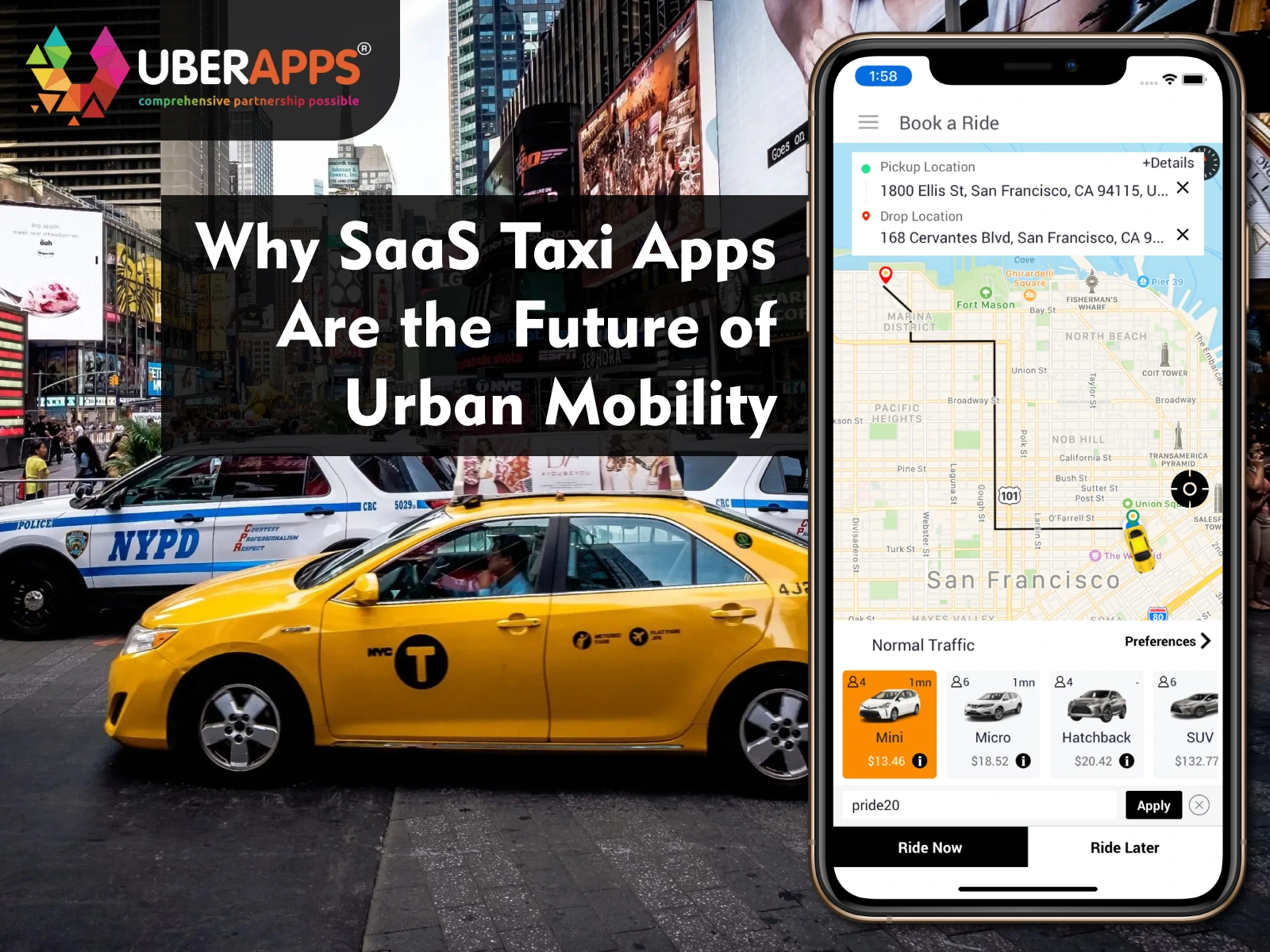
Why SaaS Taxi Apps Are the Future of Urban Mobility
Urban mobility is in the middle of a massive transformation. Just a decade ago, taxis were dispatched manually using radios and notepads. Passengers had to stand on busy streets, waving for rides, often with no guarantee of availability, safety, or fair pricing. Today, everything has changed. App-based ride-hailing has redefined how people move around cities, and at the heart of this revolution is Software as a Service (SaaS).
SaaS is not just a technology trend it’s a business model that removes the barriers of heavy investment and technical complexity. By providing ready made, cloud-based taxi platforms, SaaS is enabling entrepreneurs, fleet owners, and even small operators to compete with global ride-hailing giants. It integrates the latest innovations in IoT app development, mobile app development, connected apps, and smart device apps, making it a game-changer for urban transport in 2025 and beyond.
The future of urban mobility is being shaped by SaaS taxi apps, which combine affordability, scalability, and cutting-edge technology. Unlike traditional taxi systems, SaaS solutions launch quickly, update automatically, and integrate with IoT app development, connected apps, and smart device apps. They deliver benefits for passengers, drivers, and operators while supporting the broader vision of smart cities. From AI-driven route optimization to integrated payments and EV support, SaaS platforms are setting the standard for modern mobile app development in the taxi industry. This blog explores why SaaS taxi apps are the future of urban transport in 2025 and beyond.
The Rise of SaaS Taxi Solutions
The taxi industry has always been competitive, with thin margins and high operating costs. Traditional taxi companies had to invest heavily in servers, dispatch software, and maintenance teams. Launching a custom-built taxi app often took more than a year and required hundreds of thousands of dollars. For many small operators, this was simply not possible.
SaaS has completely rewritten this story. Instead of building from scratch, operators can now subscribe to white-label taxi platforms hosted on the cloud. This means they pay a small monthly or yearly fee and immediately gain access to apps for passengers, drivers, and administrators.
The demand for such agile solutions is skyrocketing. Startups and entrepreneurs want faster go-to-market strategies, while passengers demand seamless mobile apps that rival Uber, Bolt, and Lyft. Global statistics reflect this trend the ride-hailing industry is projected to surpass $400 billion by 2028, and a major driver of this growth will be SaaS adoption.
Why SaaS Taxi Apps Are Disrupting Urban Transport
The disruption caused by SaaS in the taxi industry comes down to four main factors:
- Lower Investment: Building apps from scratch is expensive. SaaS requires only a subscription fee, eliminating the burden of massive upfront costs.
- Speed to Market: A SaaS taxi app can be deployed in a matter of weeks, compared to months or years for custom solutions. For businesses in fast-growing markets, speed makes all the difference.
- Affordable Scaling: Subscription pricing means even small operators can launch a professional taxi service without going bankrupt. They can then scale as demand grows.
- Constant Innovation: SaaS providers regularly roll out new features, from AI-driven route optimization to IoT-powered vehicle tracking. Businesses benefit from updates instantly, without additional downtime or development costs.
This combination of affordability, flexibility, and future-readiness is why SaaS taxi apps are rapidly becoming the foundation of urban mobility ecosystems.
Key Features That Make SaaS Taxi Apps the Future
SaaS taxi apps are more than just booking platforms—they’re full-fledged mobility solutions designed to serve all stakeholders. Some standout features include:
- White-Label Branding: Operators can launch apps under their own brand identity with no mention of the SaaS provider.
- AI-Driven Route Optimization: Passengers enjoy shorter ETAs, while drivers save fuel and maximize earnings.
- Smart Payments: SaaS apps integrate multiple payment gateways, including digital wallets, UPI, credit cards, BNPL services, and even cryptocurrency.
- Global Readiness: With multi-language and multi-currency support, operators can expand across borders seamlessly.
- Analytics Dashboards: Data-driven decisions are enabled through real-time reporting on trips, revenue, and performance.
- IoT Integration: Vehicle tracking, driver monitoring, and emergency alerts rely on smart device apps powered by IoT app development.
By merging these advanced capabilities, SaaS apps are setting new standards for mobile app development in the mobility industry.
Benefits for Stakeholders
The power of SaaS taxi apps lies in the way they balance the needs of passengers, drivers, and operators.
For Passengers
Passengers benefit from instant booking, real-time tracking, transparent pricing, and digital receipts. Safety features such as SOS buttons, live trip sharing, and verified driver profiles add layers of trust. In essence, SaaS taxi apps turn daily commuting into a smooth, reliable experience.
For Drivers
For drivers, SaaS apps mean better job allocation, reduced idle time, and optimized routes. They can track their earnings in real time, receive instant payments, and enjoy fairer distribution of ride requests. The integration of connected apps ensures they never miss a trip.
For Operators
Fleet owners and taxi companies gain the most from SaaS. Automated dispatch systems reduce overhead costs, while analytics provide deep insights into rider behavior and revenue streams. Since the entire platform is cloud-based, they avoid the burden of server maintenance and focus solely on growing their business.
Why SaaS Taxi Apps Outperform Traditional Systems
Traditional taxi systems often rely on outdated dispatch methods, slow manual processes, and inconsistent passenger experiences. In contrast, SaaS platforms deliver:
- Rapid deployment that gets services live in weeks.
- Affordable scalability for small and large operators alike.
- Automatic updates that introduce new features without downtime.
- Enhanced passenger experiences powered by smooth, modern mobile apps.
These advantages make SaaS platforms not just better, but essential for anyone serious about building a sustainable taxi business in 2025 and beyond.
The Urban Mobility Shift in 2025 and Beyond
Urban transport is no longer about just getting from point A to B. The next phase of mobility involves sustainability, integration, and intelligence. SaaS taxi apps are playing a major role in shaping this future.
- Electric Vehicles and Green Mobility: SaaS platforms are integrating EV dashboards, charging station locators, and carbon footprint calculators, supporting governments’ green mobility goals.
- Smart City Integration: By connecting with municipal systems, SaaS taxi apps contribute to traffic management, congestion reduction, and smarter urban planning.
- Emerging Technologies: Trends such as AI copilots, predictive maintenance, and Mobility as a Service (MaaS) are being integrated into SaaS taxi platforms. Soon, a single app will let users book taxis, metros, buses, and bikes in one place.
In short, SaaS is no longer about just powering apps—it’s about powering smart cities.
Case Studies and Success Stories
Real-world examples prove the effectiveness of SaaS in revolutionizing taxi operations.
- In Lagos, a mid-sized taxi operator adopted a SaaS solution. Within three months, daily ride bookings grew by 40%, while operational costs dropped by 25%.
- In Berlin, a startup used a SaaS taxi platform to launch in just six weeks. Within one quarter, they scaled to 1,000 rides per day, breaking even within eight months.
These stories highlight the true ROI of SaaS—faster growth, lower costs, and better scalability.
Challenges and Considerations
While SaaS taxi apps offer many advantages, businesses must also be aware of potential challenges.
- Data Security: Passenger data must be safeguarded with strong encryption and compliance with regulations like GDPR.
- Connectivity Issues: In emerging markets with poor internet access, operators need offline booking backups.
- Market Competition: Local fleets must carve niches to compete against global ride-hailing giants.
Choosing the right SaaS provider is critical. Look for platforms that prioritize security, uptime, and localized customization.
Why SaaS Taxi Apps Are the Future – Final Take
SaaS has evolved from being just a cost-saving alternative to becoming the backbone of urban mobility. With integrated IoT app development, connected apps, smart device apps, and mobile app development frameworks, SaaS taxi solutions are shaping the cities of tomorrow.
They empower entrepreneurs to launch businesses quickly, scale without fear, and continuously innovate without added costs. For passengers, drivers, and operators, the benefits are undeniable. And for cities, SaaS taxi apps represent a step toward smarter, greener, and more connected transportation ecosystems.
Call to Action
Ready to launch your own SaaS-powered taxi app? Let our team help you build a future-ready mobility solution. Get in touch today to schedule a free consultation and discover how SaaS can help you dominate your local market.
Conclusion
Urban mobility has always been about convenience, but in 2025 it’s about much more: sustainability, intelligence, and adaptability. Traditional taxi systems simply cannot keep up with rising passenger expectations and the pace of technology. This is why SaaS taxi apps have become the foundation of modern transport systems worldwide.
By leveraging IoT app development, connected apps, smart device apps, and mobile app development, SaaS platforms offer powerful features that make rides faster, safer, and smarter. Operators enjoy reduced costs, drivers earn more efficiently, and passengers enjoy transparent, stress-free experiences. Case studies across markets from Africa to Europe prove that SaaS adoption results in real growth and profitability.
The road ahead will bring EV integration, MaaS ecosystems, and even AI copilots, but one thing is clear: SaaS will remain the backbone of these innovations.
If you’re ready to launch your own SaaS-powered taxi app, now is the time. Reach out today, take the leap, and become a leader in the future of urban mobility.
FAQS
1. Why are SaaS taxi apps better than building custom apps?
SaaS taxi apps launch faster, cost less, and are updated automatically, while custom apps require long development timelines and heavy upfront investment.
2. Can SaaS taxi apps integrate IoT features like GPS tracking?
Yes, they support IoT app development for real-time tracking, telematics, and even predictive maintenance of vehicles.
3. Are SaaS taxi apps secure for passenger data?
Leading providers use advanced encryption, GDPR compliance, and secure cloud hosting to protect passenger and driver data.
4. Do SaaS taxi apps work in small towns as well as large cities?
Yes. Thanks to subscription pricing and cloud hosting, SaaS apps scale down for small fleets and scale up for urban markets.
5. How fast can I launch my own SaaS taxi app?
Most SaaS taxi apps can go live within 1–2 weeks, compared to 2–4 weeks for custom-built platforms.
Author's Bio

Vinay Jain is the Founder of UBERApps and brings over 10 years of entrepreneurial experience. His focus revolves around software & business development and customer satisfaction.

